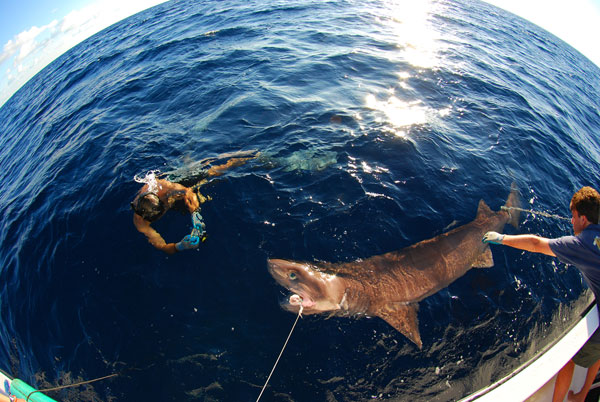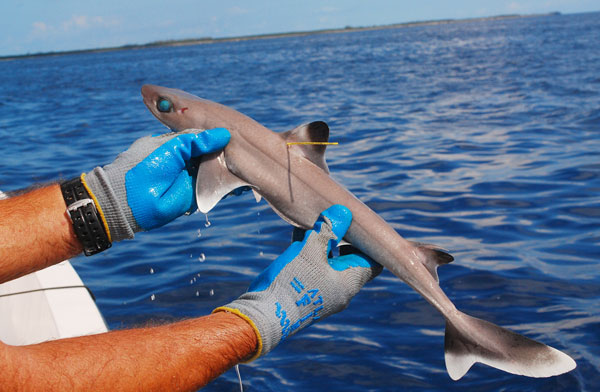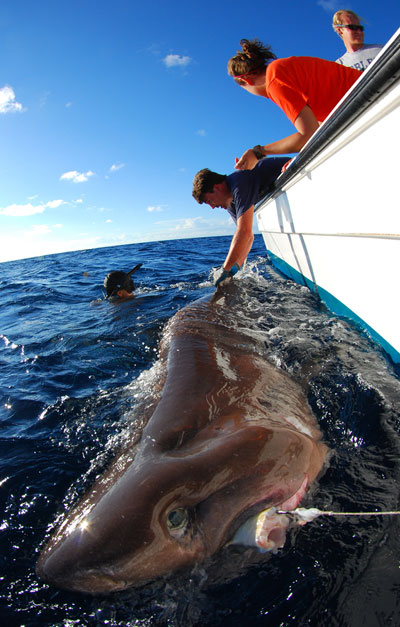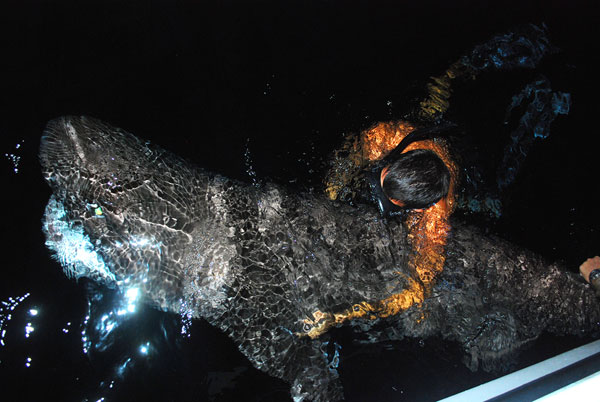
A bluntnose six gill shark is measured, tagged, identified by sex, and a small DNA sample is taken..jpg A bluntnose six gill shark is measured, tagged, identified by sex, and a small DNA sample is taken
|
Cape Eleuthera, The Bahamas -
The
Shark Research and Conservation Program
at the Cape Eleuthera Institute initiated a new research program this
week aimed at investigating the diversity and abundance of deep ocean
sharks living in The Bahamas.
Collaborating scientists Dr. Dean Grubbs of
Florida State University, Dr. Demian Chapman of
Stony Brook University, and Lucy Howey-Jordan of
Microwave Telemetry, Inc. traveled to the
Cape
Eleuthera Institute to get the project started and encountered an incredible degree of success.
Over the course of three days and six surveys, the team captured 25 animals from six different species.
These ranged from a 389 cm (13 ft) bluntnose sixgill shark to a 47 cm (18 inch) fully grown sawtail
catshark.
“I
have conducted research on deep water sharks in a number of locations
around the world including the central Pacific off Hawaii, the temperate
western Atlantic off the east coast of the USA and in the Gulf of
Mexico.
Cape Eleuthera appeared to be an ideal location to
expand my research however I never expected the incredible diversity
and abundance of species we encountered these last few days.
Twenty-five sharks from six different species on only six surveys is an incredible record.” said Dr. Dean Grubbs.
Of all the currently described species of sharks, 256, or 56%, live their entire lives below 200m (660ft) of water.
Of
these species, basic information about life history is available for
only five species, and information relating to movement patterns is
available for only three species.
Until recently these
deep-water environments acted as a refuge from human exploitation,
however, as stocks of fish closer to the ocean surface are subjected to
overfishing, commercial interests are turning their attention to the
deep.
Many of these deep-water sharks are being exploited
without any understanding of their biology and ecology on which to base
management decisions.
“The particular highlight for me was in fact the smallest shark we captured, a Springer’s sawtail catshark.
This
species was only described in 1998 and there are relatively few records
of it anywhere in the world so I am incredibly excited to encounter it
in Eleuthera,” said Dr. Dean Grubbs.
This
project is providing a unique educational experience for students from
The Island School who, alongside staff from the Shark Research and
Conservation Program, will continue to gather data over the coming
weeks.
“This is an incredibly exciting new project for the Shark Research and Conservation Program.
We
have been working on the more easily accessible sharks such as the
Caribbean reef, tiger and nurse sharks for over three years now, yet we
had no idea of the treasure-trove of new species that were right on our
door step.
The first phase of this project has been a huge
success and I cannot wait to see the rest of the data we gather over
the course of the next 12 weeks with the Island School students.
These
students are incredibly lucky as there are very few people who have
ever seen most of the species they will be working with this semester -
it’s a truly unique opportunity for them,” said Edd Brooks, Program
Manager of the Shark Research and Conservation Program at the Cape
Eleuthera Institute.

A tagged Cuban dogfish immediately prior to its release
|
In addition to monitoring the diversity and abundance of the animals encountered, the research team will
be utilizing some of newest electronic tracking technology available to monitor these animals’ movements.
So
far three pop-up satellite archival transmitters (PSATs), which record
depth, temperature and light level data which is later transmitted to a
satellite, manufactured by
Microwave Telemetry, Inc.,
have been deployed on bluntnose six gill sharks to compliment the 10
already deployed on this species by Dr. Grubbs in Hawaii, the eastern
United States and the Gulf of Mexico.
A further five will
be deployed on gulper sharks over the coming weeks providing the first
movement and habitat use data for these animals.
Until the
recent development of the X-tag there was not a PSAT small enough to
deploy on a smaller species like the gulper shark.
“The new X-Tags deployed on these sharks will provide some of the highest resolution tracking data currently on the market.
I
am really excited to be working with the team at the Cape Eleuthera
Institute because the facilities and proximity to deep water provides an
excellent opportunity to study the movement and behavior of deep-water
sharks,” said Lucy Howey-Jordan of
Microwave Telemetry, Inc.
Dr. Demian Chapman, the Assistant Director of Science at the
Institute for Ocean Conservation Science based at
Stony Brook University, who studies shark genetics and conservation, was especially impressed with the abundance of sixgill sharks.
“These
sharks have been around since well before the dinosaurs and yet we
really don’t know that much about them. Captures of two sixgill species,
including both adults and juveniles, suggests that much can be learned
about this group here in The Bahamas. Once again the Bahamas is proving
itself to be the ‘Shark Capital of the World’,” said
Dr. Demian Chapman.
The Bahamas is widely credited as being a leader in shark conservation after banning longline fishing in the late 1990s.
The
opportunity to study the wide variety of species that exists here, both
in deep and shallow water, in a relatively un-disturbed state is one
that has put The Bahamas on the map for shark researchers around the
world.
As ever the
Shark Research and Conservation Program is indebted to the Bahamian Government’s
Department of Marine Resources for providing permission for this research to be undertaken.
“The
absence of a commercial fishery of any significance for sharks in The
Bahamas, along a wide variety of marine habitats within close proximity
to the facility makes the Cape Eleuthera Institute an ideal location for
the pursuit of research into the these important species.
The
Department of Marine Resources is pleased to support shark research
being done in The Bahamas and notes the importance of the recent success
in at the Cape Eleuthera Institute in respect of understanding the
sharks of the deeper waters of The Bahamas,” said
Mr. Michael Braynen, Director of the Department of Marine Resources.

A blunt nosed six gill shark is fitted with an satellite tracking device which will monitor the sharks movements and behavior for the next five months
|
This
exciting new direction of shark research will continue to investigate
and explore the deep-water inhabitants of the Bahamas and provide much
needed information on this minimally studied area of the world’s oceans.
Given
the resounding success of the project to date, it is likely that the
deep-water shark research program will be a permanent fixture of the
Cape Eleuthera Institute’s Shark Research and Conservation Program.
Institutional Information:
The Island School:
The
Island School is a three-month semester leadership program for high
school students. Participants have come from over 300 schools to study
the tropical marine environment and take place-based courses in math,
history, English, and art. The Cape Eleuthera Institute is a marine
research facility that works with universities to model sustainable
systems and find solutions for resource management.
www.islandschool.org
Cape Eleuthera Institute:
Cape Eleuthera Institute is a marine field station situated on Cape Eleuthera, Eleuthera The Bahamas.
It
undertakes research on local environmental issues as well as acting as a
host facility for marine and terrestrial scientists and visiting
education groups of all ages. Cape Eleuthera Institute has especially
focussed on developing new methods of resource use and management
applicable to the Caribbean, such as effective use of solar energy and
local recycling of waste organic and other materials.
Its sister organisation, The Island School (www.islandschool.org),
is a semester abroad program for high school students from the US and
The Bahamas, for whom the Cape Eleuthera Institute provides hands-on
research experience through their in house research programs.
These programs include shark research, flats ecology and conservation, patch reef ecology and sustainable offshore aquaculture.
www.ceibahamas.org

Aaron Shultz, the Director of Research at the Cape Eleuthera Institute, prepares to release a 4-meter long bluntnose sixgill shark equiped with a sattelite tracking device
|
Florida State University Coastal and Marine Laboratory
:
FSUCML
is a research and educational facility on a relatively pristine stretch
of Florida’s Gulf coast approximately 100 km south of the FSU main
campus in Tallahassee.
The mission of the FSUCML is to
conduct innovative, interdisciplinary research focused on the coastal
and marine ecosystems of the northeastern Gulf of Mexico and beyond,
with a focus on solving the ecological problems faced by the region by
providing the scientific underpinnings for informed policy decisions.
Permanent faculty and graduate students conduct field and laboratory-based research on taxa ranging from seagrasses to sharks.
Ongoing
projects at FSUCML include studies of habitat use and connectivity,
genetic diversity, species life histories, food web dynamics, and
fisheries ecology.
www.marinelab.fsu.edu
Stony Brook University Institute for Ocean Conservation Science:
The
Institute for Ocean Conservation Science is dedicated to advancing
ocean conservation through science. We conduct world-class scientific
research that increases knowledge about critical threats to oceans and
their inhabitants, provides the foundation for smarter ocean policy, and
establishes new frameworks for improved ocean conservation.
www.oceanconservationscience.org
Microwave Telemetry, Inc.:
Located in Columbia, Maryland, Microwave Telemetry, Inc. has been
providing satellite-tracking technology for avian and marine scientists
for over 20 years.
Research using their technology has aided in the conservation and management of dozens of species worldwide.
For more information, visit their website at
www.microwavetelemetry.com
